Unlocking the human potential – views from the high-level meeting in Bologna
“We can do a lot, but policy makers need to be aware and familiar with the topic of disability and AT.”
Download this article here
“Change can only happen if all stakeholders are involved, and here today we have them all – represented in the panel and the audience.” With these words Evert-Jan Hoogerwerf, Secretary General of AAATE, welcomed on 27 August the 100 participants to the High-level Meeting on “Unlocking Human Potential” in the impressive Archiginnasio Stabat Mater Room of the old University of Bologna.
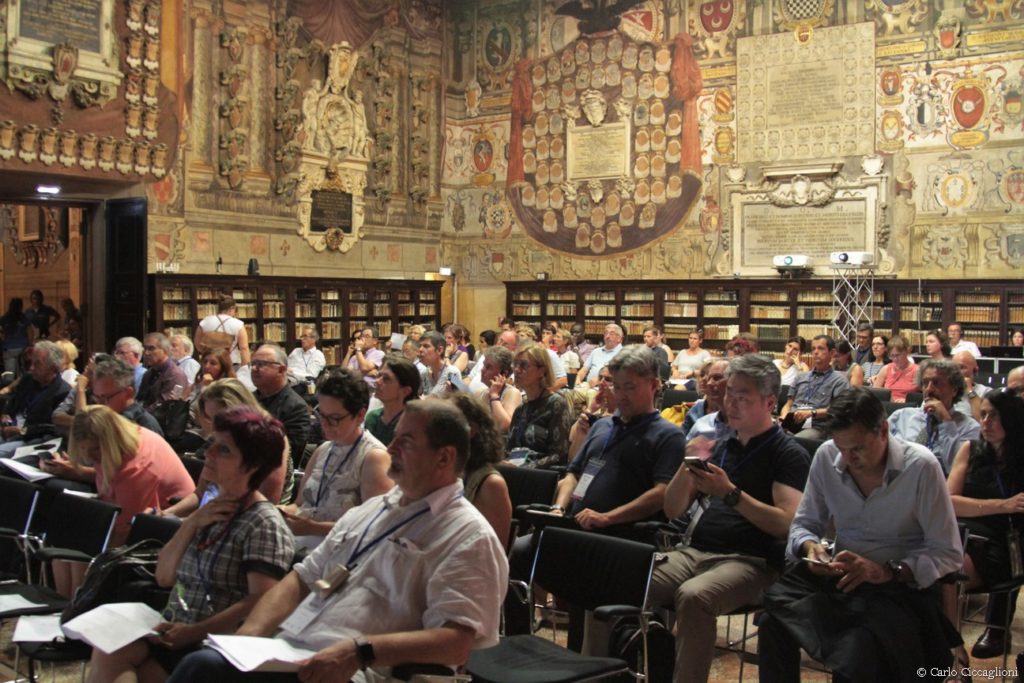
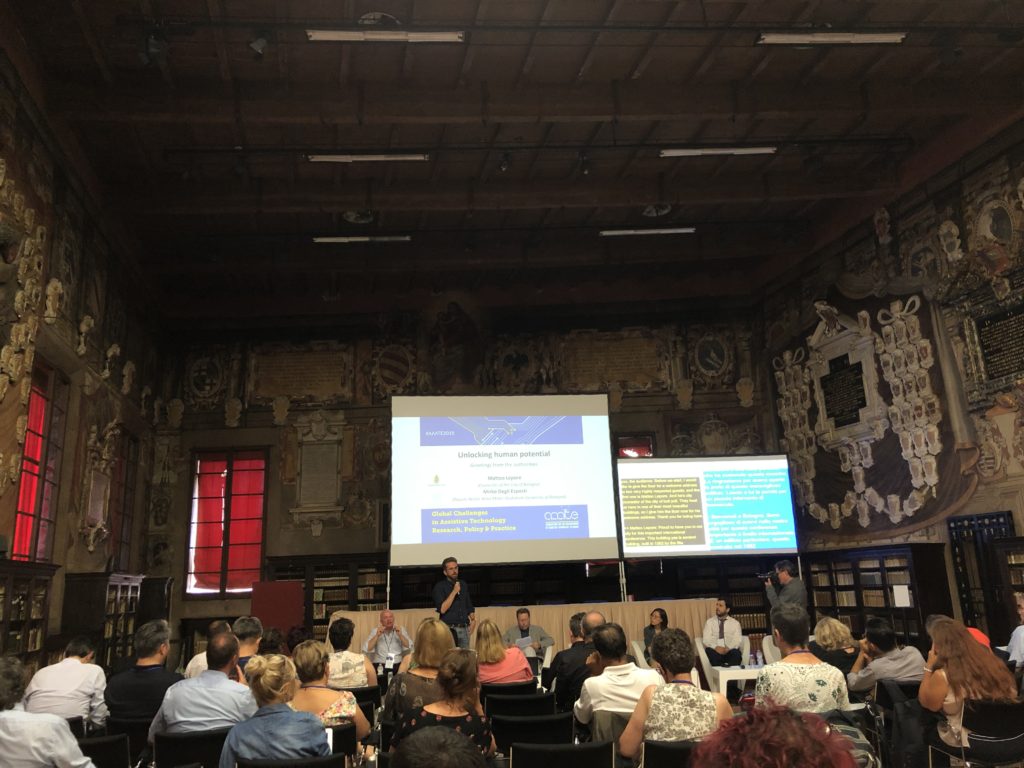
The meeting spanned a bridge between the GReAT Consultation Summit on 22-23 August 2019 in Geneva and AAATE’s 2019 conference held 28-30 August 2019 in Bologna, and had a great selection of panelists, including the World Health Organisation, the European Commission, the European Disability Forum, and representatives of national and regional authorities and civil society organizations to contribute their views on how to boost assistive technology-enabled inclusive and sustainable development at global and local level.
Mirko Degli Esposti, Deputy Rector of the University of Bologna, explained about the University’s long-standing commitment to accessibility – both in the use of AT to promote the autonomy of students with disabilities as well as in the development of tools, for example to make graphics and library services accessible to the entire community. The University offers support for students with learning disabilities, students with emotional and interpersonal difficulties and invests into research on IoT based services for this use.
Matteo Lepore, Councilor in the City of Bologna, spoke of Bologna’s spirit of freedom, which today translates into creating important solutions for everyday life, in healthcare, research and technology. Matteo wants to create a welcoming city for everyone and sees accessibility as key for the city’s future. Technology will be one of the tools to move Bologna in this direction.

Wei Zhang from the World Health Organization explained the importance of the resolution on Assistive Technology (AT) adopted in May 2018, which prioritizes two core activities: 1) technical and capacity building support, as well as 2) development of the 1st ever global report on AT. WHO furthermore assists countries in developing their own national AT programs through the GATE program which centeres around the 4 pillars of policy, people, products, and provision. The pillar of policy evolves around data and demand for AT; the pillar products resulted in WHO’s 2016 list of assistive technology products and supports the development of new technical specifications; the pillar on persons focuses on developing materials for training the AT workforce; and the pillar on provision resulted in piloting one-stop AT centers in several countries.
WHO’s goal is to reach 500 million more people with life-changing AT by 2030.
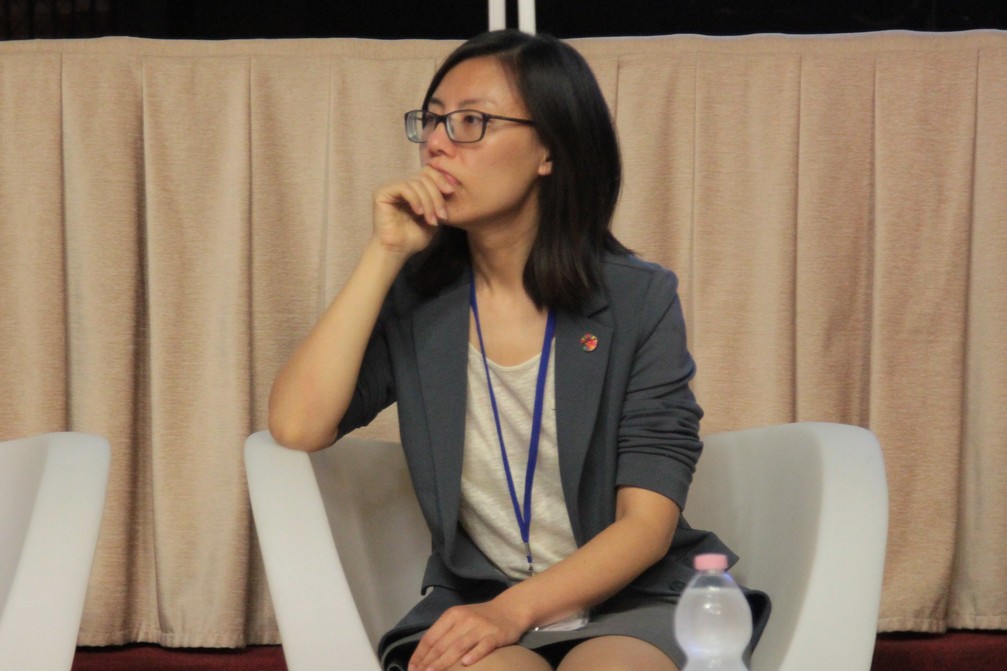
“Following the ratification of the UNCRPD, the EU has substantially advanced with policies regarding accessibility, but now comes implementation time and we need to make these policies a reality in everyday life”, said Alejandro Moledo from the European Disability Forum (EDF).

The EU has created a legislative framework for accessibility, including the Public Procurement Directive obliging authorities to buy accessible, the European Accessibility Act regulating accessibility requirements for a set list of products and services, and standards on Design for All and accessibility in new technologies. “We need accessible environments in combination with the AT appropriate for us and we need to make sure they are available and affordable”, Alejandro said. “Now is the moment in which we must influence the agenda of the EU to make sure that we keep investing in research in AT, and to make sure that the EU internal market also works for AT. All this can only happen effectively if we succeed in involving people with disabilities in this work.”
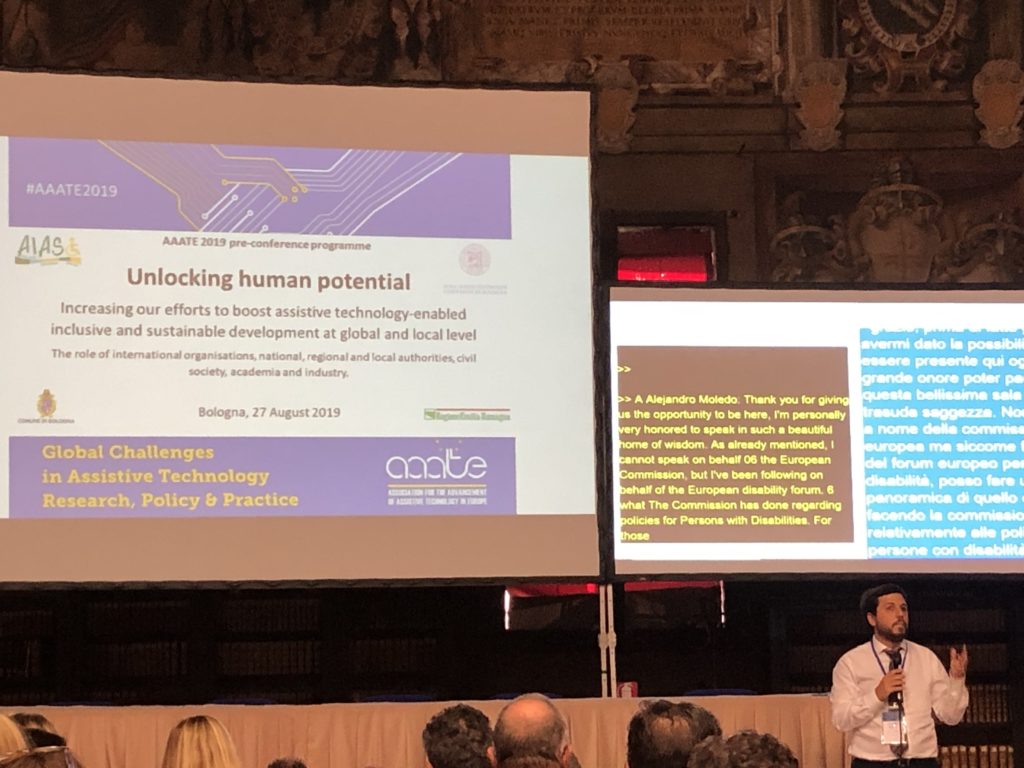
Luc de Witte followed Alejandro with two strong stories that show the incredible difference AT can make in the life of real people. He shared the experience with his nephew for which basic AT made it possible to interact with his environment and the story of a friend in Nepal who for whom a wheelchair made all the difference in moving around.
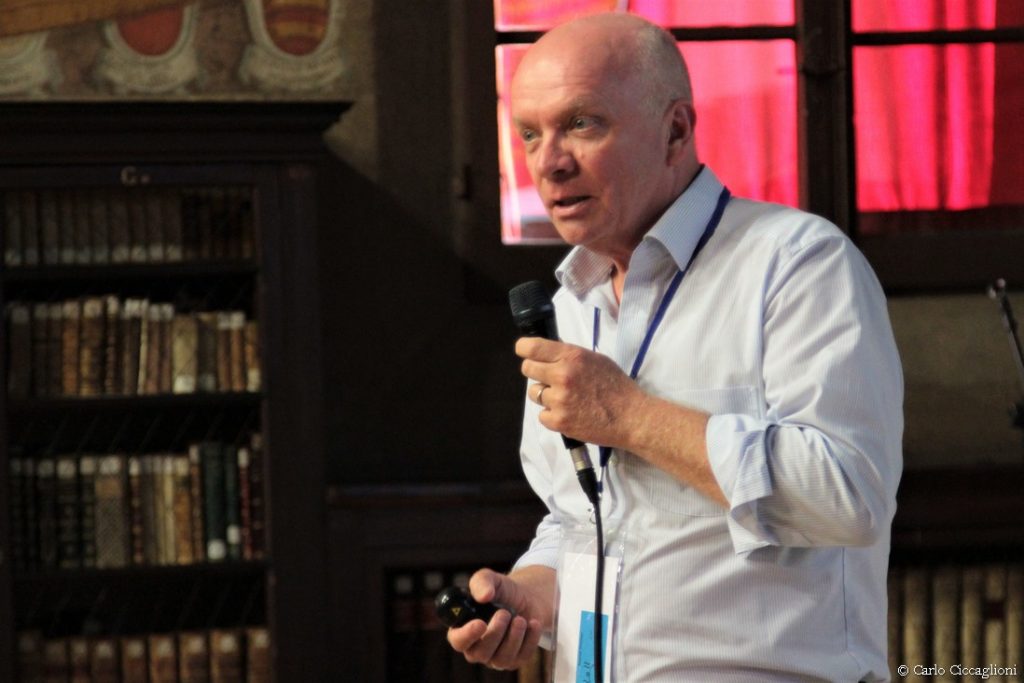
Luc is a medical doctor, but in his medical training he learned nothing about disability. Getting in touch with solutions that can help his patients or friends with disabilities was pure luck. “That’s a shame!”, he said. “And the situation is the same no matter if we talk about developed or developing countries.” A simple technology can have a huge impact, but people need to know about it!
Why bother, some might ask. Well, from just a human rights perspective it is not acceptable that people who have bad luck don’t get to have the chance to develop their potential. It is everybody’s responsibility to contribute to everyone getting equal opportunities – this includes provision with AT.
But again, the key issue is to get the existing solutions to the people. It is today easier to get a million euro in funding for some fancy AI project than to get 10,000 euro to make sure a technology gets to the people who need it. “Would it not be a nice rule to implement for all these many funded projects that at least as much money needs to be invested in getting the solution in the hands of people,” Luc suggested. He also underlined that the role of organizations like AAATE is extremely important in connecting all relevant stakeholders and create effective change on the ground.
Katerina Mavrou from the European University of Cyprus then introduced the panel on “Implementing a rights-based approach in Assistive Technology”.
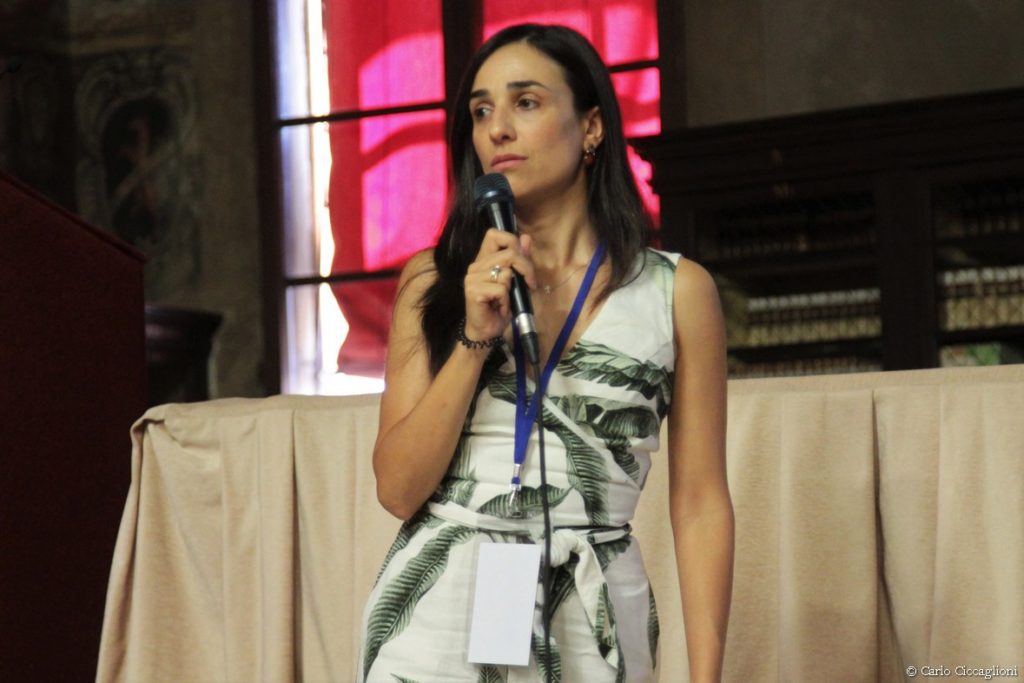
It started with a keynote by Giampiero Griffo from the Italian National observatory on the conditions of persons with disabilities. He emphasized the change in paradigm that the UNCPRD had brought by changing the approach to disability from a medical model to a human rights model. “It’s not about my condition, but about the environment and the societal attitude, whether I am excluded or included,” Giampiero underlined. The UNCRPD does not focus on a person’s condition but on the participation of the person in all aspects of society. The goal is to mainstream accessibility and this is also incorporated in the UN’s sustainable development goals: no one is to be left behind.
“Our job at international level is to empower, to habilitate people with disabilities to live with their condition, support capability and participation in different parts of life and ensure independent living,” Giampiero said.
To achieve a personalized approach based on self-determination and participation and hence a maximum of autonomy and independent living for people with disabilities, we need a standardization of tools and instruments at world level and ensure that all these solutions are compatible. It needs a comprehensive economic, cultural and ethical approach, because throughout life each person living on earth has at some point lived, lives or will live with a condition of disability.
Of course, we need to deal with the ethical issues that can come with new technological solutions – think of post-human, cyborg, AI etc. – and acknowledge that technology has its limits too. But accessibility equals sustainability and the competent participation of persons with disabilities in the development of new solutions will help deal with these issues and produce even more innovation.
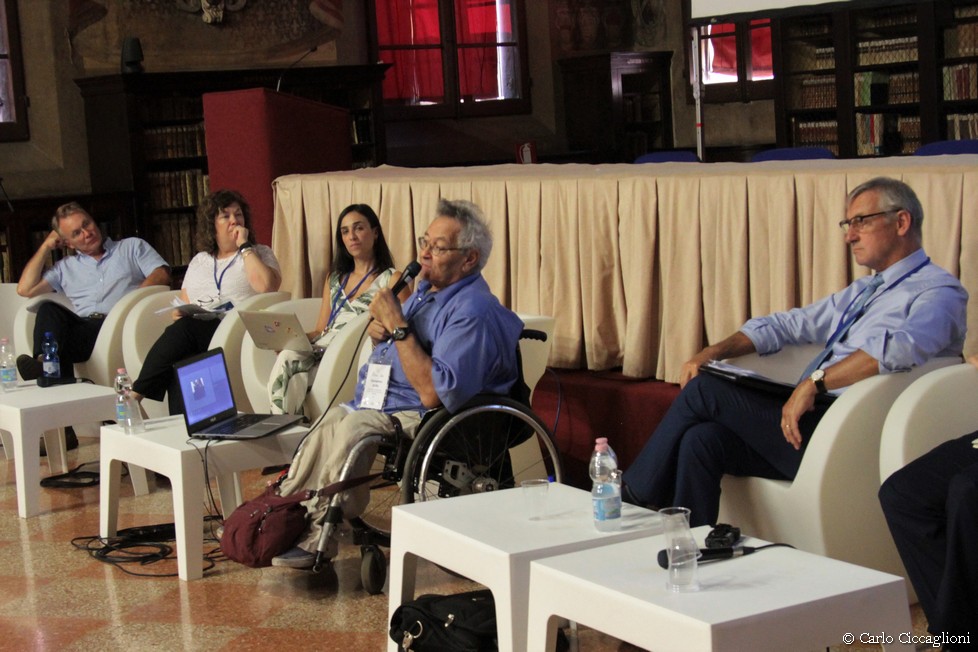
“Technology is only a means to an end,” continued Alejandro Moledo. “The goal is what people can achieve with this technology.” Universal design can ensure that the greatest number of people can use a technology and does not exclude AT. Technology is evolving and accessibility is advancing – that is the good news. But we need to keep in mind how they will work with our AT and we always need to keep in mind the context in which it is being used. The barriers we face in the advancement of accessibility and the provision of AT is often based on the prejudice that it is expensive, not efficient enough etc. However, universal design and the effective provision of AT is beneficial to the whole of society, and in particular to our aging societies. Indeed, universal design is about changing the mindset and embracing human variety.
Luk Zelderloo from the European Association of Service Providers to Persons with Disabilities (EASPD) emphasized that the link between AT and human rights is crucial. Independent living, access to justice, employment – in all these areas AT can empower people. Therefore, these items should be on the agenda for the new disability strategy 2020-2030 and the next EU budget should cater for both AT and accessibility.
We need to find ways of professionals becoming a lever for AT, and of course AT must become a part of their curricula. We say that AT is directly linked to the enjoyment of human rights, yet we are broadening the concept of disability and by doing so and making the group of effected people broader and broader, we are also spreading the resources. The danger is that his way, we might take the necessary resources away from those with very severe and costly support needs. We have to work together, network, learn from each other and try to avoid such pitfalls while also working together to make a difference.
“The connection between AT and human rights is a connection of persuasion,” Malcolm MacLachlan from Maynooth University in Ireland continued. There is no way to have enough resources to provide what we would like people to have, despite having the UNCRPD ratified by so many countries. And while the report coming out of the GReAT Consulation will be a crucial document, it cannot make countries implement AT services – that has to be driven on national level and we need to help governments and policy makers prioritize AT despite the many demands on them. For this reason, we need to look at what the policy makers need to achieve and propose appropriate solutions. Technology can help to make the most excluded people the most included but you might be surprised just how many policy makers just don’t know how to do that. They do not know the potential of assistive technology. We do need to pang on the table to make them aware, but most importantly we need to develop good persuasive arguments and show policy makers how AT can help them achieve their goals.
Tara Rudnicki from the Assistive Technology Industry Association (ATIA) shared an example from a developed country, namely the US, that demonstrates well some of the issues the AT sector faces. A few years ago, the government decided that communication devices for ASL patients would not be funded anymore. The AT sector banded together and managed to get congress to overrule this and recognize that communication is a human right and the funding of these devices would continue.

Egidio Sosio, Disability manager of the City of Bologna, and Rabih Chattat from the University of Bologna, joined the tenor of their panel by underlining the importance of AT in reducing differences and facilitating autonomy, independence and participation. Egidio emphasized the importance of AT also in administration to give people access to city services.
The final session of this high-level meeting was dedicated to “Creating conditions for AT to work”, chaired by Serenella Besio from the University of Bergamo. It kicked off with Massimo Guerreschi explaining about the great benefits achieved through the national cooperation of Italian AT centres in the GLIC consortium.
Cathy Holloway from the Global Disability Innovation Hub emphasized that policy people need a roadmap – there is a huge amount of work being realized on the ground, great polices developed but no one is connecting the pieces. She suggested to focus on four areas: 1) data and evidence – although there is a huge argument on what that should be, 2) developing a capacity tool to understand how ready a country is to deliver AT internally, 3) innovation, and 4) capacity and participation. To achieve this, we need global partnerships to move the agenda forward.
Renzo Andrich from the EASTIN network followed on with three key priorities: 1) disseminating information on existing products – too many people in the world who would need AT do not know about it, 2) education of AT users – information is not enough, you need to have the knowledge and skills to make the choices and then be a demanding consumer towards the provider, and 3) education of community carers, general practitioners etc.
To tackle these issues, Renzo invited the international participants to encourage the appropriate partners in their countries to collaborate with EASTIN, who has found a way to aggregate the information from different countries into a central source of information on available AT solutions. He also suggested to develop training packages, aggregating the many ongoing initiatives by WHO and individual universities and others into one central place.
Silvana Contepomi from the Argentinian Assistive Technology Association confirmed the importance of awareness. People need to understand that the appropriate use of the AT can lead to full participation in society. Education also plays a role – education in the needs assessment, in providing AT, in training, in the follow-up. And finally, an emphasis needs to be placed on driving policy through a community-based approach: no Latin American government will change a policy based on research results, they would only change if they see good results in participation.

Roger Smith from the Rehabilitation Engineering and Assistive Technology Society of North America (RESNA), said we need to think about the interdisciplinary dimension of AT: it is not one perspective, one industry, one technology…. Cross-technology use is really important as people are often affected by more than one disability, yet on the ground we have all these specializations which become really difficult for our students, our faculties and our consumers.
Filippo Borghi from AssoAusili started with the needs of the users. First of all, we need to spread the knowledge about existing AT solutions as there are still many professionals in rehab that have no idea about AT and are therefore not in the position to recommend appropriate AT to their patients. Then we need to work on better assessment of needs. An efficient assessment must be the 1st step and we need more competence in the needs assessment in our AT centres.
Maria Caterina Manca from the Commission for Health and Welfare, City of Bologna, joined into the call for more awareness: “We can do a lot, but policy makers need to be aware and familiar with the topic of disability and AT.”
While AT is important, it needs to come in the correct order, said Massimiliano Malavasi from the Regional Centre for Assistive Technology of Emilia Romagna. We need to improve the quality of our selection and provision processes. The best way to support people with disabilities is when the AT provision point becomes a hub where rehab services, social services, and families work together with the person with disability. Additionally, AT should be a support not only for the user but also play a role for research, policy and industry. We need to shift from focusing on delivering a device to AT systems and services.
Inmaculada Placencia-Porrero from the European Commission closed the circle of presentations with a short recap of where we started with AT in Europe, what we have achieved and what lays ahead. Ima has started working on AT in the 90ies. Some of the challenges faced then, we are still facing today: technology has developed a lot, but the services and policies have not. And it remains a challenge to coordinate between health services, social services and technology.
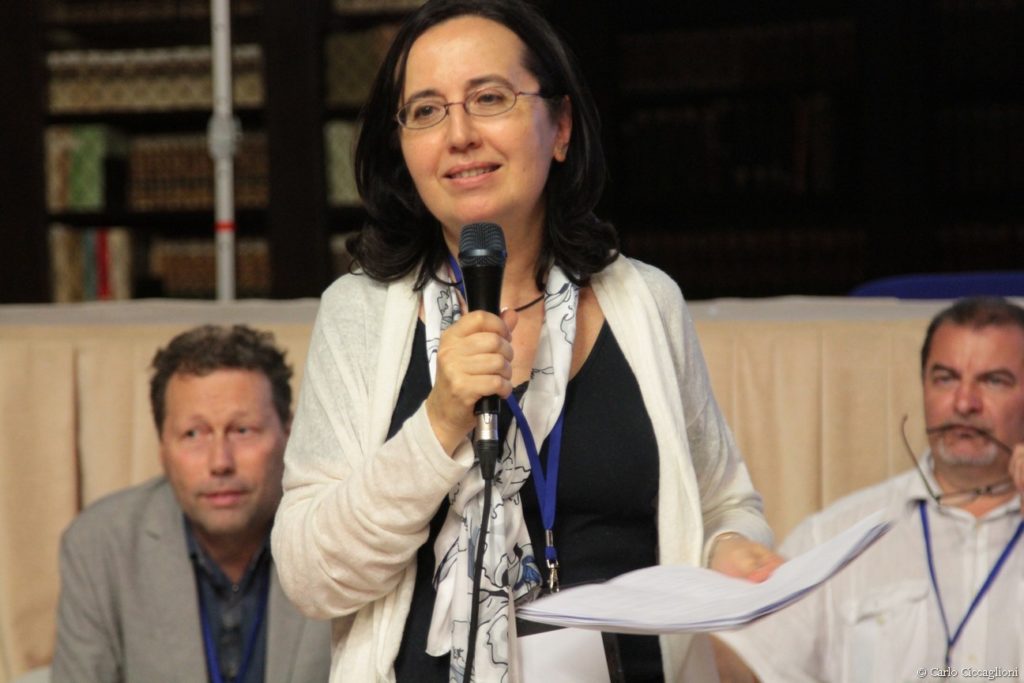
When looking at the AT market, we need to distinguish between low tech aids, high tech or medical devices – and the services that are needed with them. Technology has developed a lot, but are we using the latest technology appropriately? Elderly persons with vision impairment and hearing-aids often still face difficulties in changing the batteries in their devices, while youngsters have ear-pods that charge wirelessly…. We also have a fragmentation in certifications, different AT lists, differences in insurances access and so on.
The European Commission is proud that the just adopted European Accessibility Act includes the requirement for interoperability with AT. And the EU is just now finishing the decade of the last European disability strategy. There is much more to be done and Ima invited the audience to participate in the ongoing public consultation on what the EU should focus on in its next 10-year disability strategy.

The meeting concluded with a presentation of the new Global Alliance of Assistive Technology Organizations (GAATO) and the announcement of the Bologna Declaration, in the writing of which many of the panelists had contributed. The text of the Declaration was updated with the conclusions from this meeting and put online with the invitation to all participants and their organizations to endorse the Declaration, endorse the included action steps and together move the AT sector forward: https://aaate.net/the-bologna-declaration/
